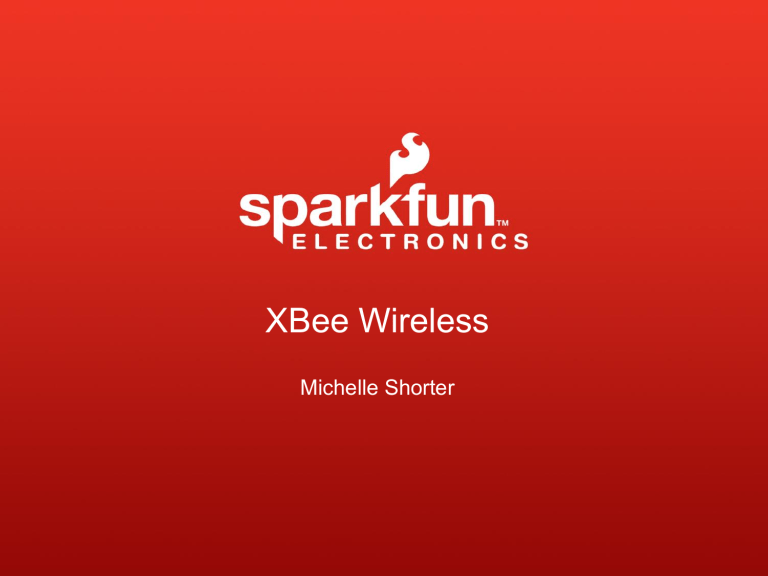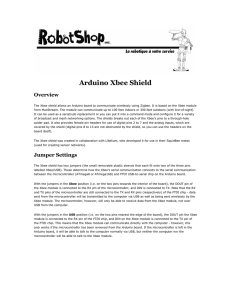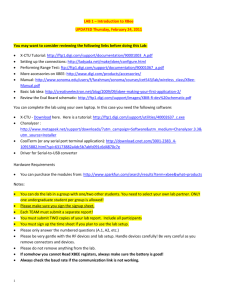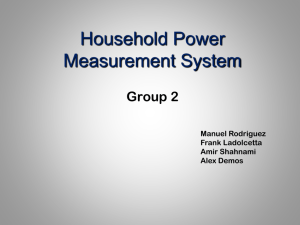XBee Series 1 and 2 Presentation

XBee Wireless
Michelle Shorter
Radio Communication
• Electromagnetic Waves
• No medium required
• Modulation
• Well described mystery
• Wireless/Airwaves
• Inverse Square Law
802.15.4
• Low Power
• Low bandwidth
• Addressing
• Affordable
• Small
• Standardized
• Popular
802.15.4 Configurations
• Single Peer
• Multi Peer
• Broadcast
Zigbee
• Layer on top of 802.15.4
• Routing (pass messages on)
• Ad-hoc network creation
• Self-healing
• Star
Zigbee Configurations
• Mesh
• Chip
Antennas
• Whip
• u.FL
• RPSMA
Regular vs. Pro
• 1-2mW
• Smaller
• Shorter range (100m)
• Cheaper
• 50-60mW
• Longer
• Longer range (300m)
• More expensive
Addressing
Addressing
• Channels
• PAN
• 64-bit address
• High -0013A200 same for all XBees
• Low – each XBee has its own address
• 16-bit address (configurable on Series 1)
Coordinators
• Each network has 1 coordinator
• Coordinator selects channel and PAN ID
• Other devices then join the PAN
• Usually powered by something stable
• 16-bit address is always 0
• Assigns 16-bit address for the router and end devices
Routers
• Optional
• Often powered by something stable
• Can have as many as you want
• Issues a request on startup to find a coordinator/network it can join
• Can talk to any device
• If an end device is sleeping it stores its data
• Coordinator can act as a “super router”
End Devices
• Optional
• Usually battery powered
• Can have as many as you want
• Issues a request on startup to find a network it can join and a parent device
(router or coordinator)
• Can only communicate with its parent
Firmware
• Must upload with X-CTU (on Windows)
• AT firmware vs API firmware
• Coordinator, Router, End Device
• Other
• Each Firmware has different settings
Contrary to this picture X-CTU will not work on your Mac
How to Hookup your XBee
• Breakout Board
• Xbee Explorer
• Xbee Explorer Regulated
• Xbee Shield
Terminal Windows
• X-CTU
• Hyperterm (doesn't come with Windows
7)
• Coolterm (Windows, Mac, Linux)
• Unix/Linux terminal window
• Plenty of others
9600-8-N-1
Getting into Command Mode
• +++ gets you into command mode
• 1 second delay on either side
• No <enter>
• Should get “OK” back
• Times out after 10 seconds
AT Commands
• AT – just returns an “OK”
• ATMY – 16- bit address (Series 1 only)
• ATDH – 64-bit destination address high bits
• ATDL – 64-bit destination address low bits
• ATID – PAN ID
• ATCN – end command mode
• ATRE – reset all settings
• ATWR – write settings to flash
Sending Commands
• Just typing the AT command will give you the setting
• Typing the AT command followed by a value sets the value
• Commands use Hexadecimals
• Always Press Enter
• >ATID 1111
• OK
• >ATID
• 1111
• >ATWR
• OK
Chat Program
I/O Series 1 vs Series 2
• 8 Digital I/Os
• 7 Analog Inputs
• 2 Analog Outputs
(PWM)
• Can't use these all at once
• Straight through
I/Os
• Must use Vref
• 10 Digital I/Os
• 4 Analog inputs
• No Analog outputs
• Can't use these all at once
• I/O pins are 1.2V only
To use or not to use
• Saves space
• Save power
• Save weight
• Save money
• Reduce complication
• Limited I/Os
• No logic
• No analog output
• Added Complexity
I/O Commands
• ATD0...D7 configure pins 0-7
• ATP0...P1 configure pins 10,11
• ATIR set the sample rate (in ms)
• Always sends 1 sample per transmission
• Data is sent to destination address
Commands for Series 1 Only
• ATIT samples before transmit (1 for
Series 2, configurable for Series 1)
• ATIA – I/O addresses (who can play with my pins)
ATDx Command Options
• 0 - Disabled
• 1 – Built-in function (sometimes)
• 2 – Analog Input (sometimes)
• 3 – Digital Input
• 4 - Digital Output (low to start)
• 5 – Digital Output (high to start)
Voltage Divider
Serial Sensor Project
Why use a Microcontroller
• Local logic
• Fast prototyping
• I2C, PWM, SPI
• More I/Os
• Xbee Series 2 only allows 1 side of I/O
Arduino HW Serial vs
NewSoftSerial
• 1 Serial port on Uno
• 4 Serial ports on
Mega
• Connected to USB port
• Unlimited serial ports*
• Requires more processing power
• More likely to loose data
• Higher baud rates less likely to work
• *as many as the processor can handle
API Mode?
• Application Programing Interface
• For computers to talk to other computers
• Structured
• Predictable
• Reliable
• Frames of data
• Radio must be in API mode
• ATAP 1 for Series 1 (ATAP 0 to turn off)
• API firmware for Series 2
API Frame Data
Color Project
Gateways
• Connect your Xbee to something else
• Bluetooth
• Ethernet
• Cell Modules
• WiFi
• RFID
• Many others
Digi's Connect Ports
• X8 – Ethernet, Wifi, Cell, USB, serial...
$1000
• X5 – Satellite Radio, cell, WiFi, GPS... $1000
• X4 – Ethernet/Wifi, cell $700
• X3 – GSM/FPRS... $250
• X2 – Ethernet or WiFi
• $100-$200
• Sparkfun WRL-10569
• (Ethernet version)
• $140
iDigi
• Free account with up to 5 Connect Ports
• Remote access your connect port
• Update firmware on other Xbees in the network
• Firmware updates
• Remote Reboot
X2 Example
Troubleshooting
• Only use 3.3V, more than 7 will release magic smoke
• Use decoupling capacitors with a voltage regulator
• TX->RX RX->TX
• Don't overwhelm them, try putting in a small delay
Questions?
www.sparkfun.com
6175 Longbow Drive, Suite 200
Boulder, Colorado 80301











